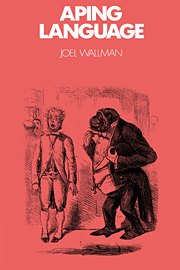8 - Primate communication in nature
Published online by Cambridge University Press: 03 November 2009
Summary
The literature on naturalistic primate communication has something for everyone – those seeking to document continuity between human language and infrahuman communication as well as those promoting a natural hiatus. Despite this lack of consensus, I think it is accurate to describe the literature as providing much more support for the discontinuity position.
The issues in the primate-communication literature bearing on the origin of language lend themselves to a number of contrasts. Some of these contrasts are dichotomous, while others define a continuum of possibilities, with language at one end and primate systems, if not at the other, than at least elsewhere. It will be apparent that several of the oppositions presented in the following pages are conceptually linked; in a more meticulous treatment, some might prove to be essentially synonymous oppositions.
VOCAL–AUDITORY VERSUS OTHER CHANNELS
Human linguistic exchanges typically employ a visual channel, parallel to the Vocal–Auditory one, which contains information conveyed by such “paralinguistic” means as hand gestures, body attitude, and facial expression. In addition, the Vocal–Auditory channel, through such aspects as pitch, stress, and volume, carries information supplementary to the “words” themselves, information about the speaker's current emotional disposition in general, toward the listener, and regarding the objects of reference in the discourse, as well as clues about the speaker's personal identity, age, gender, geographic origin, and so forth. It is the verbal content of the Vocal–Auditory channel, nonetheless, that is properly considered the central information in language; far more of what is distinctive in human communication would be lost by deleting the words of a conversation than by blocking out the gestures and facial expressions.
- Type
- Chapter
- Information
- Aping Language , pp. 128 - 146Publisher: Cambridge University PressPrint publication year: 1992



